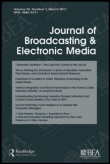
JOURNAL OF BROADCASTING & ELECTRONIC MEDIA
Scope & Guideline
Exploring the Frontiers of Media Innovation
Introduction
Aims and Scopes
- Media and Communication Studies:
The journal delves into the theoretical and practical aspects of media and communication, exploring how they influence public perception, behavior, and societal norms. - Digital Media and Technology:
Research on the impact of digital platforms, social media, and emerging technologies on content creation, distribution, and consumption is a central theme. - Cultural Representation and Identity:
The journal examines how media representations shape and reflect cultural identities, particularly concerning marginalized groups and issues of diversity. - Political Communication:
Investigating the role of media in politics, including electoral processes, public opinion, and the influence of partisan media on political behavior. - Health Communication:
The journal includes studies on the role of media in health communication, addressing public health messaging, misinformation, and the impact of media on health behaviors. - Critical Media Literacy:
Promoting understanding of media effects and encouraging critical engagement with media content is a recurrent focus, especially in the context of misinformation and disinformation. - Crisis Communication:
Research on how media facilitates communication during crises, including public health emergencies, natural disasters, and political upheaval.
Trending and Emerging
- Misinformation and Disinformation:
The prevalence of misinformation, especially during crises like the COVID-19 pandemic, has prompted a growing body of research focused on understanding its spread, effects, and strategies for mitigation. - Impact of Artificial Intelligence and Algorithms:
Emerging studies are increasingly examining the role of AI and algorithms in shaping media consumption, news personalization, and the implications for public discourse. - Interactive and Participatory Media:
Research on how interactive media, including livestreaming and social media platforms, fosters community engagement and participatory culture is gaining traction. - Health and Crisis Communication:
With the ongoing global health challenges, research focusing on health communication strategies, including the role of media in public health messaging, is becoming more prominent. - Political Polarization and Media Consumption:
Investigations into how media consumption patterns contribute to political polarization and affect public discourse have emerged as critical areas of inquiry. - Cultural and Gender Representation:
Studies examining the representation of gender and cultural identities in media, particularly in the context of social justice and activism, are on the rise. - Effects of Streaming and On-Demand Content:
As streaming services revolutionize media consumption, research exploring their effects on audience behavior, content production, and industry dynamics is increasingly relevant.
Declining or Waning
- Traditional Broadcasting Models:
As digital media consumption continues to rise, traditional broadcasting models and their associated studies have become less prevalent, with a shift towards digital platforms and streaming services. - Linear Television Analysis:
Research specifically focused on the linear television format is decreasing, as audiences increasingly engage with on-demand and streaming services, leading to a need for new analytical frameworks. - Media Effects Research in Isolation:
Studies examining media effects in isolation without considering the broader socio-political context are becoming less common, as researchers increasingly adopt interdisciplinary approaches. - Focus on Local News:
There has been a noticeable decline in research centered on local news coverage and its impact, as the focus shifts to global and national narratives in the context of digital media. - Nostalgic Media Studies:
Investigations into nostalgic media representations are waning, possibly due to a generational shift in media consumption patterns and interests.
Similar Journals
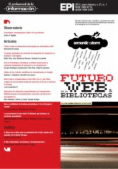
Profesional de la Informacion
Fostering Excellence in Information and Communication StudiesProfesional de la Informacion is a leading academic journal dedicated to advancing research in the fields of Communication, Cultural Studies, Information Systems, and Library and Information Sciences. Published by EDICIONES PROFESIONALES INFORMACION SL-EPI, this journal has established itself as a pivotal resource for scholars and practitioners alike since its inception in 2006, holding an impressive Q1 ranking across its categories in 2023. With an impactful presence reflected in its Scopus Rankings—33rd out of 511 in Communication and 26th out of 280 in Library and Information Sciences—Profesional de la Informacion provides a forum for innovative research and discussion. Although it operates under a subscription model, the journal’s commitment to quality research contributes significantly to the knowledge base within its fields, making it an essential read for those who are passionate about information and communication studies. Positioned in the vibrant academic landscape of Barcelona, Spain, this journal encourages submissions that explore contemporary challenges and advancements in these vital areas of study, solidifying its role as a cornerstone of scholarly discourse.

Tijdschrift voor Communicatiewetenschap
Cultivating Dialogue in the Realm of CommunicationTijdschrift voor Communicatiewetenschap is a prominent academic journal published by Amsterdam University Press, specializing in the dynamic field of communication studies. With an ISSN of 1384-6930 and an E-ISSN of 1875-7286, this journal plays a vital role in disseminating high-quality research, theoretical advancements, and practical insights related to communication theory and practice. Despite its Q3 rank in the Communication category, it serves as a crucial platform for scholars and practitioners, striving to bridge gaps in knowledge and promote interdisciplinary dialogue. The journal's impact is reflected in its lineage of contributions from leading authors in the field. While the journal is not openly accessible, its curated content remains invaluable for researchers, professionals, and students eager to stay at the forefront of communication scholarship. With publications spanning from 2008 to 2024, 'Tijdschrift voor Communicatiewetenschap' continues to foster the development of communication sciences from its base in Amsterdam, Netherlands.

Media International Australia
Advancing Scholarly Dialogue in Media StudiesMedia International Australia is a leading journal that occupies a unique position at the intersection of communication and cultural studies. Published by SAGE Publications Ltd, this journal has established itself as a vital platform for scholarly discourse since its inception, now converging efforts from 2008 to 2024. With an impressive Q1 ranking in both the Communication and Cultural Studies categories, it ranks 12th out of 1304 in Cultural Studies and 42nd out of 511 in Communication, placing it within the 99th and 91st percentiles respectively according to Scopus metrics. The journal is committed to providing access to rigorous research that reflects contemporary issues in media, making it essential reading for researchers, professionals, and students keen on advancing their understanding of media's role in society. Despite not being fully Open Access, it ensures that quality research remains accessible through institutional subscriptions, allowing a broad audience to benefit from its insightful contributions.
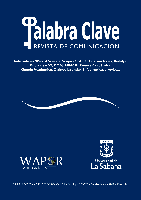
Palabra Clave
Exploring Contemporary Issues with Critical InsightPalabra Clave is a leading open-access journal published by the UNIV SABANA, FAC COMUNICACION in Colombia, dedicated to advancing the fields of Arts and Humanities as well as Communication. Since its inception in 2001, the journal has committed to providing a platform for innovative research and critical discourse, garnering an impressive Q2 classification in both respective fields. The journal is indexed in Scopus, with a commendable ranking of #26 out of 173 in Arts and Humanities, representing the 85th percentile, and #263 out of 511 in the Communication category, indicating its significant impact within the academic community. With its converged years from 2012 to 2024, Palabra Clave encourages scholars, professionals, and students to engage with contemporary issues through a lens of interdisciplinary scholarship. Accessible through its open-access model, this journal fosters the democratization of knowledge and aims to connect researchers across the globe.
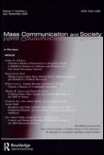
Mass Communication and Society
Illuminating the Pathways of Communication in Modern SocietyMass Communication and Society is an esteemed journal published by Routledge Journals, Taylor & Francis Ltd, focusing on the dynamic field of communication studies. With its ISSN 1520-5436 and E-ISSN 1532-7825, the journal has established itself as a leading platform for high-quality research since its inception. With a prestigious positioning in the Q1 category of Communication as of 2023, it ranks impressively at #45 out of 511 in Scopus within the social sciences communication sector, boasting a 91st percentile in its field. The journal serves as a vital resource for researchers, professionals, and students interested in emergent issues, theories, and methodologies related to mass communication and its impact on society. Although it does not offer Open Access options, the journal remains committed to advancing scholarly discourse and providing rigorous insights into how communication shapes social dynamics. Since its converged years from 2008 to 2024, Mass Communication and Society continues to push the boundaries of knowledge in a rapidly evolving academic landscape, making it a must-read for anyone invested in the communication discipline.

Journal of African Media Studies
Connecting Culture and Society Through Media Research.Journal of African Media Studies, published by INTELLECT LTD, stands at the forefront of communication research, focusing on the rich tapestry of media practices and theories across the African continent. Since its inception in 2011, this peer-reviewed journal has dedicated itself to exploring the intricate relationships between media, culture, and society in Africa, contributing significantly to the global discourse on communication. With an impressive impact factor positioning it in Q2 of the Communication category for 2023, and ranking #218 out of 511 in the Scopus Social Sciences Communication field, it offers a rigorous platform for scholars and practitioners alike. The journal's commitment to quality research is evident in its robust editorial process and its regular publication of articles that delve into contemporary issues affecting African media landscapes. Despite being a subscription-based journal, it attracts an engaged readership interested in accessing critical insights and advancing knowledge in media studies. As it converges its timeline towards 2024, Journal of African Media Studies continues to be an essential resource for researchers, professionals, and students eager to contribute to and explore the evolving narratives of African media.

Online Journal of Communication and Media Technologies
Bridging Theory and Practice in Modern Media LandscapesThe Online Journal of Communication and Media Technologies, published by Bastas Publications DOO in Cyprus, stands as a crucial platform for scholars and practitioners in the rapidly evolving fields of communication, media, and technology. With an ISSN of 1986-3497, this journal addresses a diverse range of topics at the intersection of these disciplines, making significant contributions to both theoretical frameworks and practical applications. As a recognized entity in the academic community, it boasts impressive rankings in Scopus, such as Q2 in Communication and Q2 in Media Technology, illustrating its impact and relevance. Researchers will appreciate its open access model, which facilitates knowledge dissemination and engagement among audiences. By fostering a collaborative environment for innovative ideas and research findings, the journal not only advances academic inquiry but also supports the professional development of its readership in navigating the complexities of modern media landscapes. Aiming to bridge the gap between theory and practice, the Online Journal of Communication and Media Technologies is an essential resource for those who wish to stay at the forefront of communication and media research from 2019 through 2024.
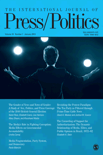
International Journal of Press-Politics
Championing Scholarly Excellence in the Press-Politics SphereThe International Journal of Press-Politics, published by SAGE Publications Inc, stands as a premier scholarly platform at the intersection of communication, sociology, and political science. With a distinguished history dating back to its inception in 2003 and maintaining its relevance through 2024, this journal is recognized in the academic community for its rigorous exploration of the dynamics between the media and political processes. The journal proudly holds a Q1 ranking in both Communication and Sociology and Political Science categories, placing it in the top tier of its field, underscored by its impressive Scopus rankings, which reflect its global influence and reach. With an intention to foster innovative research and discourse, IJPP is committed to being accessible, contributing significantly to the understanding of how press and politics shape societal narratives, thus serving as an essential resource for researchers, professionals, and students alike. Explore this esteemed journal to engage with cutting-edge studies that drive the field forward.
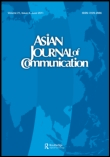
Asian Journal of Communication
Empowering Researchers with Insightful PerspectivesThe Asian Journal of Communication, published by Routledge Journals, Taylor & Francis Ltd, is a premier scholarly platform dedicated to advancing the field of communication studies. Established in 1990 and continuing its impactful publication journey through 2024, this esteemed journal caters to a broad spectrum of interdisciplinary research, addressing critical issues in communication, media, and education in an Asian context. With an impressive impact factor and ranked in the top quartiles in both Communication (Q1) and Education (Q2), the journal is recognized for its rigorous peer-review process and its commitment to quality scholarship. Researchers, professionals, and students can access invaluable insights and innovative research trends, helping to bridge gaps and foster understanding across diverse communication practices. The journal is accessible through institutional subscriptions and promotes global discourse, making it an essential resource for anyone engaged in the vibrant field of communication.

Analisi-Quaderns de Comunicacio i Cultura
Navigating the evolving narratives of culture and communication.Analisi-Quaderns de Comunicacio i Cultura, published by Universitat Autònoma de Barcelona, is a distinguished open-access journal that has been serving as a pivotal platform for interdisciplinary research in Communication and Cultural Studies since its inception. With an ISSN of 0211-2175 and E-ISSN 2340-5236, this journal not only contributes significantly to its fields, as evidenced by its impressive rankings—Q2 in Communication and Q1 in Cultural Studies for 2023—but also boasts strong Scopus placements, including a rank of 181 out of 1304 in Cultural Studies. The journal's commitment to open access since 2010 ensures that research findings are readily available to a global audience, fostering collaboration among scholars, practitioners, and students. Located in Cerdanyola del Vallès, Barcelona, this publication invites contributions that explore the dynamic and rapidly evolving intersections of culture and communication, making it an essential resource for those seeking to advance knowledge and engage critically in these essential areas of study.